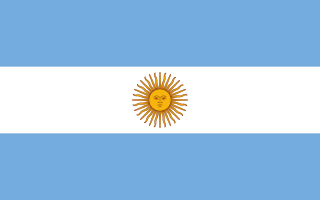 W
WThe Kingdom of Araucanía and Patagonia was an unrecognized state declared by two ordinances on November 17, 1860 and November 20, 1860 from Antoine de Tounens, a French lawyer and adventurer, who claimed that the regions of Araucanía and eastern Patagonia did not depend of any other states and proclaimed himself king of Araucanía and Patagonia. He had the support of some Mapuche lonkos around a small area in Araucanía, who thought he could help them maintain their independence from the Chilean and Argentinian governments.
 W
WThe Argentine Confederation was the last predecessor state of modern Argentina; its name is still one of the official names of the country according to the Argentine Constitution, Article 35. It was the name of the country from 1831 to 1852, when the provinces were organized as a confederation without a head of state. The governor of Buenos Aires Province managed foreign relations during this time. Under his rule, the Argentine Confederation resisted attacks by Brazil, Bolivia, Uruguay, France and the UK, as well as other Argentine factions during the Argentine Civil Wars.
 W
WThe State of Buenos Aires was a secessionist republic resulting from the overthrow of the Argentine Confederation government in the Province of Buenos Aires on September 11, 1852. The State of Buenos Aires was never recognized by the Confederation or by foreign nations; it remained, however, nominally independent under its own government and constitution. Buenos Aires rejoined the Argentine Confederation after the former's victory at the Battle of Pavón in 1861.
 W
WThe Republic of Entre Ríos was a short-lived republic in South America in the early nineteenth century. Comprising approximately 166,980 km2 (64,470 sq mi) of what are today the Argentine provinces of Entre Ríos and Corrientes, the country was founded in 1820 by the caudillo General Francisco Ramírez and lasted only one year. On September 28, 1821, Lucio Norberto Mansilla was elected Governor of the Province of Entre Rios, and the Republic was subsequently dissolved.
 W
WGeneral Sarmiento Partido was a partido in the Province of Buenos Aires, which was located in the northwest of Greater Buenos Aires.
 W
WNew León Governorate or Magellanic Lands (1529−?) was one of the colonial governorates of the Spanish Empire, located in southern South America.
 W
WThe Governorate of the Río de la Plata (1549−1776) was one of the governorates of the Spanish Empire. It was created in 1549 by Spain in the area around the Río de la Plata.
 W
WNew Andalusia Governorate was one of the colonial governorates of the Spanish Empire, located in southern South America.
 W
WThe occupation of the Falkland Islands and of South Georgia and the South Sandwich Islands was the short-lived Argentine occupation of a group of British islands in the South Atlantic whose sovereignty has long been disputed by Argentina. Until their invasion on 2 April 1982 by the Argentine military junta, they had been governed by the United Kingdom since it re-established control over them in 1833.
 W
WThe Real Audiencia de Buenos Aires, were two audiencias, or highest courts, of the Spanish crown, which lived in Buenos Aires. The authority of the first extended to the territory of the Governorate of the Río de la Plata and operated from 1661 to 1671. The second began to function in 1783 and had as its territory the areas of the Viceroyalty of the Río de la Plata not covered by the Audiencia de Charcas, that is to say the intendancies of Buenos Aires, Córdoba del Tucumán, Salta del Tucumán and Paraguay. In 1810, after the May Revolution, it was suspended, and in 1813 the Assembly of the Year XIII permanently disbanded it. The Audiencias lived in the city's cabildo building.
 W
WThe Republic of Tucumán was a short-lived state centered on the town of San Miguel de Tucumán in today's Argentina that was formed after the collapse of central authority in 1820, and that broke up the next year. The "Republic" remained a political unit within the United Provinces of the Río de la Plata.
 W
WThe United Provinces of the Río de la Plata, earlier known as the United Provinces of South America, a union of provinces in the Río de la Plata region of South America, emerged from the May Revolution in 1810 and the Argentine War of Independence of 1810–1818. It comprised most of the former Viceroyalty of the Río de la Plata dependencies and had Buenos Aires as its capital.
 W
WThe Viceroyalty of the Río de la Plata was the last to be organized and also the shortest-lived of the Viceroyalties of the Spanish Empire in the Americas.